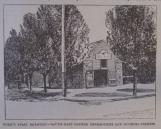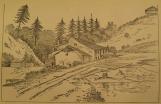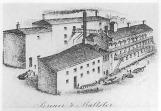1
Early inhabitants of Toronto, or York as it was known before 1834, had travelled long distances to settle in the burgeoning community. Resourcefulness was a necessity. Residents confronted significant challenges as they cleared land, built buildings, established governance structures and created commercial establishments to address both the necessities and comforts of life. Beer-making was one activity that addressed community wants and needs. As one would imagine, breweries were relatively small in the early days of Toronto, but by the second half of the 19th century, large-scale breweries were established to serve the growing markets for this alchoholic beverage.This section contains images of the breweries, some of the personalities behind the breweries, as well as labels and other ephemera from the brewing establishments.
2
York's First Brewery1800 - 1856
Duchess St (now Richmond St) and Caroline St (now Sherbourne St), Toronto, Canada
 Credits:
Credits:Image: from "Landmarks of Toronto", by John Ross Robertson, V. 1, p. 495
3
Bloor's Brewery, 1830-186419th century, 1830 - 1864
Bloor and Sherbourne Streets, Toronto, Canada
 Credits:
Credits:Image source: "Landmarks of Toronto", John Ross Robertson, v. 5, p. 535
see Bowering, Ian, "The Art and Mystery of Brewing in Ontario", Burnstown, ON; General Store Publishing, 1988
4
Bloor's Brewery, 1830-186419th Century, 1830 - 1864
Bloor and Sherbourne Streets, Toronto, Canada
 Credits:
Credits:Image: in Robertson, John Ross, "Landmarks of Toronto", vol 5, p. 535
Bowering, Ian, "The Art and Mystery of Brewing in Ontario", Burnstown, ON; General Store Publishing, 1988
5
According to Wikipedia, beer is the world's oldest and most widely consumed alcoholic beverage and the third most popular drink overall, after water and tea. It is produced by the brewing and fermentation of starches, mainly derived from cereals - the most common of which is malted barley, although wheat, corn, and rice are also widely used. Most beer is flavoured with hops, which add bitterness and act as a natural preservative, though other flavourings such as herbs or fruit may occasionally be included6
Farr's Brewery1817-1890
Queen Street West, just west of Bellwoods Ave, Toronto, Canada
 Credits:
Credits:"Landmarks of Toronto", by John Ross Robertson, volume 1, p.202
7
Farr's Brewery - another view1817-1890
Queen Street West, just west of Bellwoods Ave, Toronto, Canada
 Credits:
Credits:"Landmarks of Toronto", by John Ross Robertson, Vol. 1 1894, p. 204
8
Plan of Enoch Turner's Property19 September 1854
Parliament St. and King St., Toronto, Canada
 Credits:
Credits:Plan by John G. Howard, collection: Toronto Reference Library, plan #825
9
Enoch Turner, Brewer (1792 - 1866)1960s
Parliament St. and King St., Toronto, Canada
 Credits:
Credits:Photo: courtesy of Enoch Turner Schoolhouse Museum, Toronto, Canada
10
Doel Homestead and Brewery, 1827-1847mid-19th century
Bay St. and Adelaide St., Toronto, Canada
 Credits:
Credits:Illustration: Robertson, JR, "Landmarks of Toronto", vol 1, p. 54
11
John Doelmid 19th century
Bay St. and Adelaide St., Toronto, Canada
 Credits:
Credits:"Landmarks of Toronto", John Ross Robertson, vol 1, p. 52
12
Severn's Brewery1835 - 1886
east side of Yonge St, just north of Davenport Rd, Toronto, Canada
 Credits:
Credits:"Landmarks of Toronto", by John Ross Robertson, 1894, Volume 1, p 212
13
Severn's Yorkville Brewery, 1835-1886about 1870
east side of Yonge St, just north of Davenport Rd, Toronto, Canada
 Credits:
Credits:from "The Art and Mystery of Brewing in Ontario", by Ian Bowering, 1988, p. 95 (original in Toronto Reference Library, E:4-79B)
14
Helliwell Breweryearly to mid 19th century
Upper Don Valley, Toronto, Canada
 Credits:
Credits:Illustration: in "Landmarks of Toronto", by John Ross Robertson, 1894, vol 1, p. 427